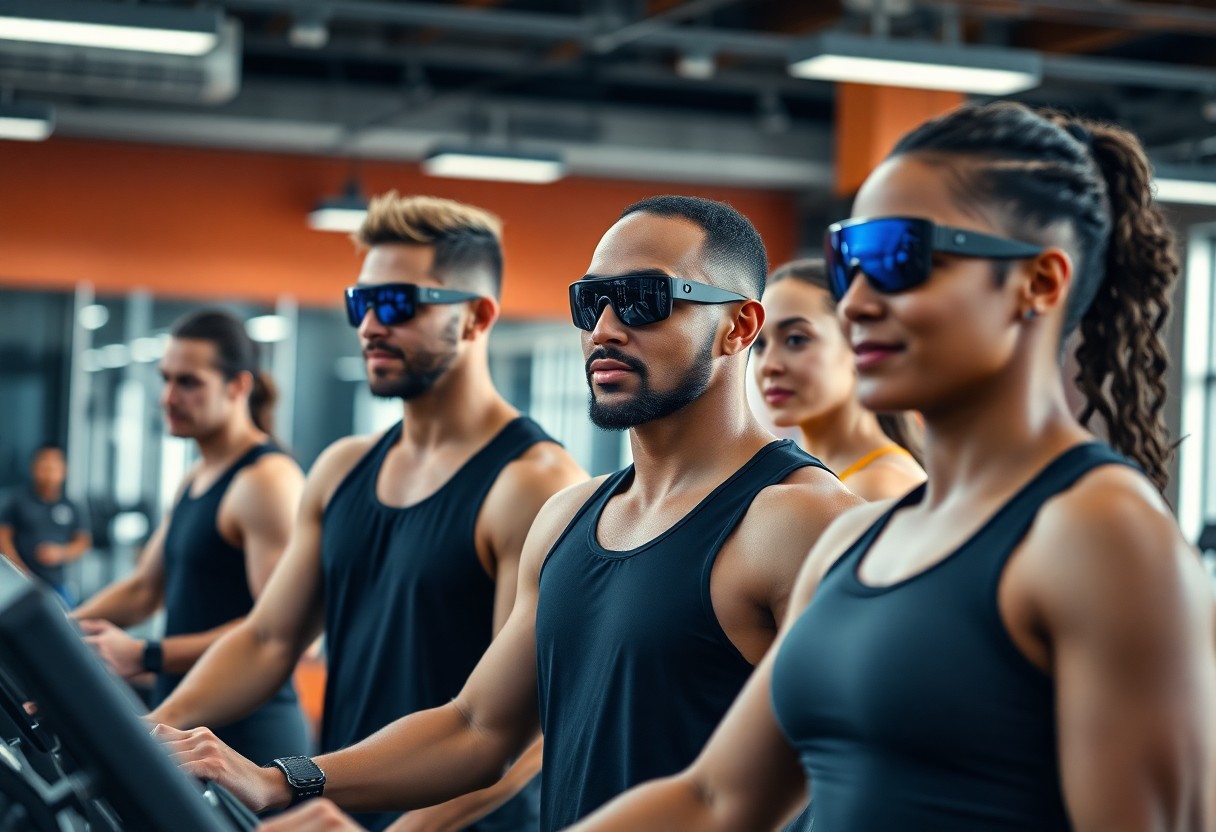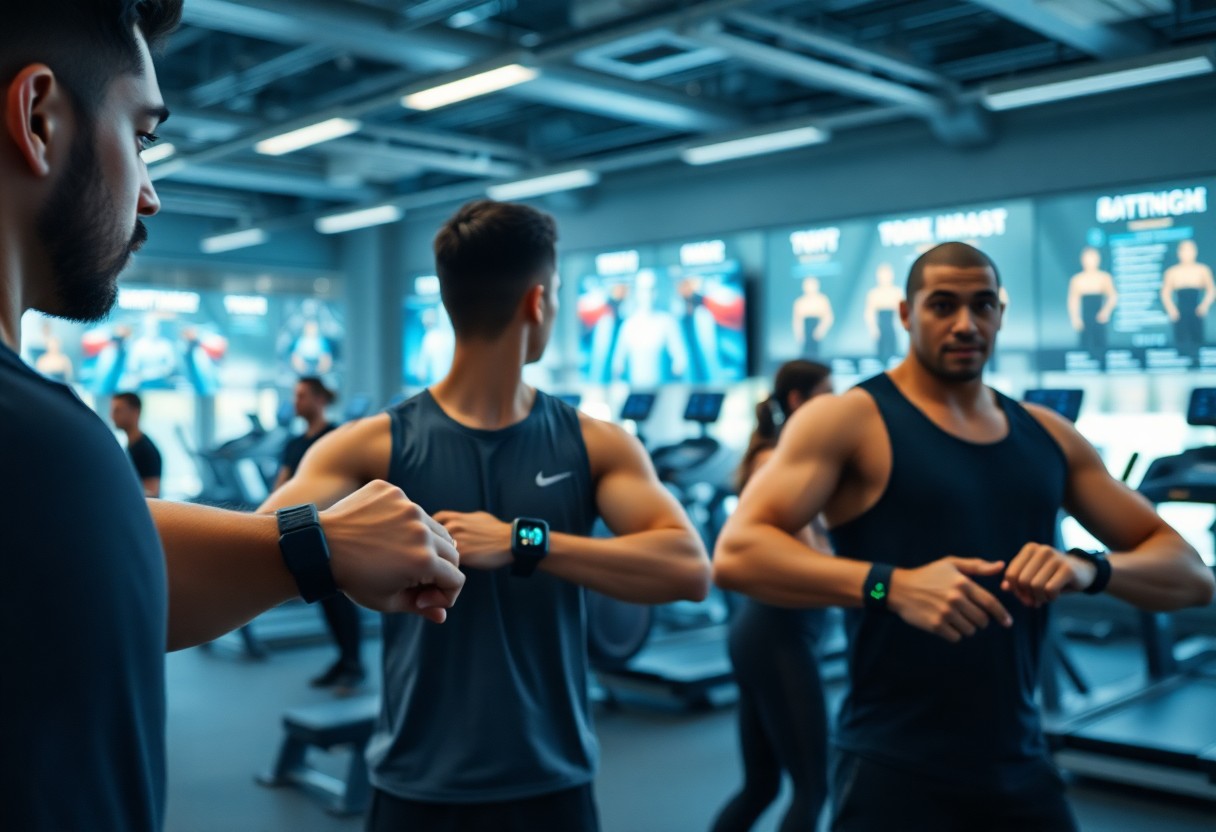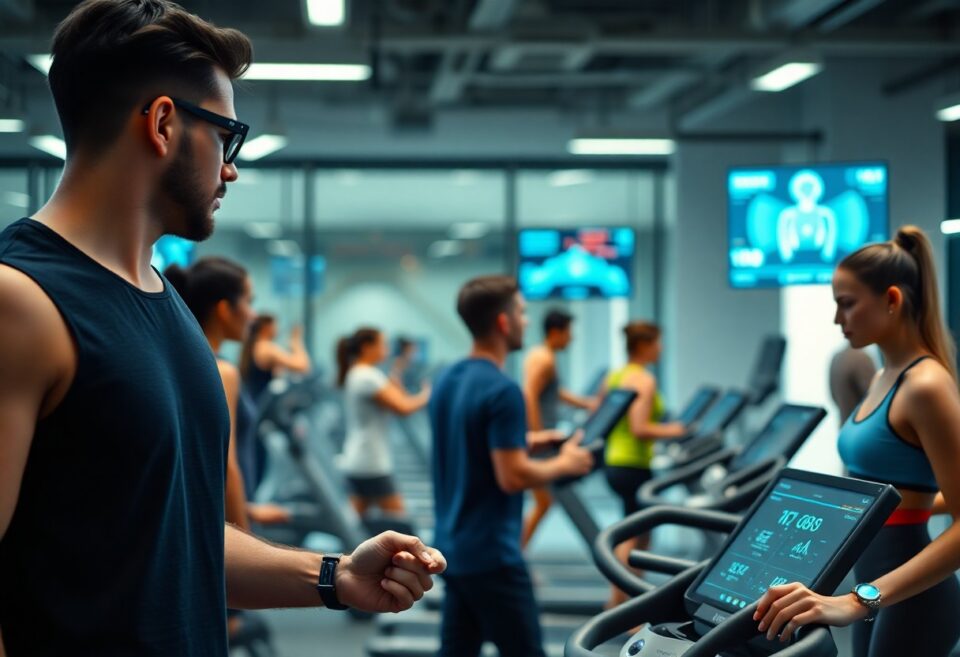In the ever-evolving landscape of fitness, gym technology is undergoing a radical transformation as you prepare to harness the power of wearables and AI like never before. These innovations not only track your every move and biometrics with precision but also provide personalized workout adjustments in real-time. However, the integration of AI raises concerns about data privacy and ethical use, aspects you should be aware of as you adopt new tools. Embracing these advancements means your fitness journey will be smarter, more efficient, and deeply connected to your unique goals and health metrics.
Tracking Progress with Advanced Metrics
In terms of your fitness journey, traditional metrics like weight and repetition counts are no longer enough. Gym tech in 2025 leverages advanced sensors and AI algorithms to provide a deeper look into your progress. You can now track biomechanical data such as joint angles, muscle activation, and even sweat composition in real time. These metrics give you a more detailed understanding of your body’s response to training, allowing you to fine-tune your workouts and avoid plateaus.
Thanks to wearables embedded with multi-sensor arrays and AI-powered platforms, your progress tracking becomes incredibly comprehensive. You can set precise goals based on metrics like muscle fatigue, recovery rate, and cardiovascular strain. By analyzing these factors, the technology helps you optimize your training intensity and volume to maximize gains without risking injury. This level of insight provides a clear pathway toward continual improvement tailored specifically to your physiology.
Here is a detailed overview of some of the leading advanced metrics that you can expect to encounter in the gym technology of 2025:
- Real-time muscle fatigue estimation
- Joint load and movement analysis
- Recovery status and readiness scores
- Hydration and electrolyte balance monitoring
- Metabolic rate tracking during exercise
| Metric | Benefit for You |
|---|---|
| Muscle Fatigue Estimation | Helps you avoid overtraining by indicating when muscles are nearing exhaustion. |
| Joint Load Analysis | Reduces injury risk by highlighting stress points during complex movements. |
| Recovery Status | Optimizes workout scheduling by telling you when your body is ready for the next session. |
| Hydration Monitoring | Keeps you informed about fluid balance for maintaining peak performance. |
| Metabolic Rate Tracking | Allows you to fine-tune calorie burn estimates and nutritional requirements. |
Integration of Health Data for Personal Insights
With the increasing sophistication of gym technology, you now have the ability to integrate your exercise data with broader health metrics gathered from various devices and apps. This comprehensive data integration offers you personal insights that go beyond simple workout statistics. By combining sleep quality, nutrition, mental health indicators, and genetic information with your fitness metrics, AI systems generate highly individualized recommendations that can reshape how you approach your overall wellness.
This integration enables a holistic view of your health that identifies patterns and interactions between different aspects of your lifestyle. For instance, poor sleep or nutritional deficiencies can be directly correlated with decreased gym performance or longer recovery times, so you receive guidance that targets these underlying causes. However, such detailed data merging can also raise privacy concerns. You should take proper steps to protect your sensitive health information, as unauthorized access could lead to misuse or identity vulnerabilities.
Ultimately, when you utilize this interconnected data ecosystem, it amplifies your ability to make informed decisions tailored uniquely to your body’s needs. This trend represents a major advancement in personal fitness, ensuring your training is safer, more efficient, and aligned with your long-term health goals.
The integration of health data with gym technology in 2025 allows you to see your fitness not as isolated sessions or stats but as part of an interconnected wellness journey. This approach means your workouts, dietary habits, sleep routines, and stress management strategies are all aligned through AI-driven insights that adapt as your needs evolve. By embracing this innovation, you empower yourself to harness a smarter, more personalized path toward optimal health and performance.
AI-Driven Custom Workout Plans
In the near future of gym technology, AI-driven custom workout plans will revolutionize how you approach fitness. Unlike generic programs, these personalized plans are created by analyzing a comprehensive set of your personal data — including your age, weight, fitness goals, injury history, and even genetic markers. This depth of information allows AI to continuously fine-tune your workout routines, ensuring they remain effective and aligned with your evolving needs. As a result, you won’t have to worry about plateaus or stagnation since your plan adapts dynamically to keep challenging your body appropriately.
This technology leverages machine learning algorithms that digest data from various wearables and fitness trackers you wear throughout your day. By observing your performance patterns, recovery times, and even sleep quality, AI can recommend adjustments not only to the intensity and volume of your exercises but also to the timing and type. In doing so, it maximizes your results and reduces the risk of overtraining or injury, helping you make consistent progress without guesswork or trial and error.
What sets AI-driven workout plans apart is their ability to simulate what-if scenarios rapidly and respond to your feedback in real time. If you are struggling with a particular movement, feeling overly fatigued, or excited to push harder, the AI recalibrates your sessions accordingly. This personalized interaction ensures that your exercise regimen truly fits your lifestyle and preferences, providing a level of precision and adaptability that traditional human trainers cannot match comprehensively.
Real-Time Feedback and Adjustments
As you engage in your workouts, real-time feedback and adjustments powered by AI and sensor technology will become your new standard. Your wearable devices will continuously monitor your biomechanical data — including heart rate, muscle activation, joint angles, and balance — to immediately detect form deviations or signs of fatigue. When the system spots an issue that could compromise your performance or safety, it will alert you instantly and suggest modifications tailored to your current physical state.
This immediate response capability helps prevent injuries by catching potentially harmful movements before they cause strain or damage. For example, if your knee alignment during a squat begins to veer dangerously, your AI coach will prompt you to correct your stance or lighten the weight. Moreover, it will recognize optimal performance moments and might advise you to increase intensity or add a set when you demonstrate capacity, helping you push your limits safely and efficiently.
Beyond injury prevention and performance optimization, real-time feedback enriches your workout experience psychologically. Receiving interactive guidance and encouragement through your wearable’s interface can boost your motivation and focus, making every session feel more engaging and personalized. This proactive collaboration between you and your tech fosters a sustainable fitness journey where progress is meticulously tracked and supported in the moment.
The benefits of real-time feedback and adjustments extend deeply into your training safety and effectiveness. Unlike manual tracking, which you might find distracting or imprecise, AI systems act instantly to correct your form and pace, significantly reducing the risk of harmful mistakes. However, it’s important to be mindful that over-reliance on these technologies can potentially dull your ability to listen to your body’s natural signals. Therefore, combining AI’s precision with your intuition provides the best approach to maintaining a balanced, healthful workout routine.

Connecting Devices for a Seamless Experience
When you step into a gym or set up your home workout space, the technology that powers your fitness routine is no longer isolated. Instead, your devices communicate with each other to create an interconnected ecosystem designed to enhance every movement you make. Imagine your smartwatch tracking your heart rate while simultaneously syncing data with your smart mirror that offers real-time form corrections and AI-generated workout adjustments. This integration allows your fitness regimen to adapt dynamically, providing you with a more intuitive and personalized experience than ever before. The smooth handoff of data between wearables, smart equipment, and your preferred fitness apps ensures you maintain momentum and avoid any disruptive interruptions during your session.
As you continue using these advanced gym technologies, one of the most exciting developments is the ability to control multiple devices through centralized hubs or even voice commands. This means you can change settings on your treadmill through your fitness tracker or adjust resistance levels on a connected bike using your smartphone. The elimination of manual input across different machines not only saves time but also reduces the risk of disjointed training sessions, where inconsistent data might otherwise cause confusion. It’s this level of device harmony that fosters an immersive, focused environment where your efforts translate into measurable results more efficiently.
However, the interconnected nature of these systems also introduces significant considerations regarding data security and privacy. When your workout progress, biometric data, and personal preferences are constantly shared among various platforms, there is an increased vulnerability to breaches or unauthorized access. You must stay vigilant in managing your security settings and choosing devices from reputable manufacturers focused on safeguarding your information. Despite these risks, the advantages of a connected gym ecosystem provide unparalleled convenience and motivation, empowering you to push your fitness boundaries in ways that were not previously possible.
Gamification of Workouts through Technology
Transforming exercise into an engaging, game-like experience is one of the most transformative trends in fitness technology right now. By integrating elements such as leaderboards, challenges, and rewards within your workout apps and devices, you’re encouraged to stay consistent and elevate your performance. This gamification taps into your natural competitive instincts and desire for achievement, making even the most repetitive routines feel fresh and thrilling. With augmented reality and virtual reality environments becoming more sophisticated, you can immerse yourself in scenarios where your physical activity directly impacts the game landscape, boosting both fun and fitness outcomes simultaneously.
As you participate in gamified workouts, you’ll notice that social connectivity plays a pivotal role in maintaining your motivation. Many platforms allow you to connect with friends or fellow fitness enthusiasts, encouraging friendly competition or collaborative goals. This social layer enhances your commitment, as you’re no longer exercising in isolation but part of an active community pushing toward mutual success. The sense of accomplishment that comes with leveling up or achieving virtual badges substitutes for traditional rewards, and in many cases, this psychological reinforcement can be a powerful driver for long-term adherence to your fitness goals.
While gamification introduces a fun and motivating approach, there is also the potential pitfall of focusing excessively on scores or achievements rather than the quality and sustainability of your workouts. You might find yourself prioritizing short-term gains or pushing beyond your limits to climb leaderboards, which could lead to injury or burnout if not monitored carefully. It’s necessary to balance the competitive excitement with mindful training practices to ensure your fitness journey remains both rewarding and safe. When harnessed responsibly, gamification provides an innovative tool to transform exercise into a captivating, socially connected adventure.
To put it briefly, gamification in gym technology is a multifaceted trend that not only enhances motivation and engagement but also leverages social connectivity and immersive experiences to redefine how you perceive and perform your workouts. As these systems continue to evolve, they offer you new opportunities to blend fitness with fun, harnessing digital innovations that keep you coming back for more while achieving measurable progress.

Understanding the Risks of Data Collection
When you use wearable devices and AI-powered gym equipment, a vast amount of personal data about your health, fitness habits, and even location is continuously being gathered. This data can provide powerful insights to optimize your workouts, but it also raises significant privacy concerns. If the data is improperly managed or accessed by unauthorized parties, you risk having your sensitive information exploited for purposes beyond your control. For example, your workout patterns and biometric information could be sold to advertisers or, worse, used to make discriminatory decisions affecting your insurance premiums or employment opportunities.
Your awareness of these risks should extend to the fact that many gyms and fitness app providers store your information on cloud servers, which may not always have rigorous security measures. Vulnerabilities in these systems can lead to data breaches, exposing your personal information to hackers who can misuse it for identity theft or financial fraud. Additionally, some AI algorithms analyze not just your exercise data but combine it with other publicly available or purchased information, creating detailed profiles that may be shared with third parties without your explicit consent.
Furthermore, the continuous collection of your data means that even small lapses in security can have long-term consequences. You might think that deleting an app or stopping use of a device removes your information, but often companies retain your data indefinitely. These accumulated records could eventually be targeted during cyberattacks or legal requests, placing your privacy at persistent risk. Therefore, understanding how your data is handled is an important step toward protecting yourself in an increasingly digital fitness landscape.
Strategies for Protecting Personal Information
To safeguard your personal information when using gym technology, start by carefully reviewing the privacy policies of wearables and fitness apps you choose. Look for transparent disclosures about what data is collected, how it is stored, and with whom it is shared. You should aim to select platforms that allow you to control your data preferences, including options to limit data sharing or delete your information entirely. Enabling two-factor authentication adds an extra layer of security to your accounts, making unauthorized access more difficult even if login credentials are compromised.
Another effective strategy involves regularly updating the software and firmware of your wearable devices and applications. Developers frequently release updates that patch security vulnerabilities and enhance data protection measures. By staying current with these updates, you reduce the chances of exploitation by cyber threats. Additionally, be cautious about connecting your fitness devices to other apps or services, only linking those you fully trust and that maintain strong privacy standards.
When possible, consider using devices that process data locally rather than uploading everything to the cloud. This approach limits the amount of information transmitted over the internet and can reduce exposure to third-party breaches. Finally, you might explore options to anonymize or encrypt your data, preventing it from being easily traced back to you. Taking these proactive steps helps ensure that your fitness journey remains private and secure as technology continues to evolve.
Protecting your personal information calls for ongoing vigilance and informed choices. By actively managing privacy settings, staying updated on security practices, and choosing trustworthy technologies, you significantly mitigate the risks associated with data collection in the gym tech space. This empowers you not just to benefit from cutting-edge devices and AI but to do so with confidence that your sensitive information is well-guarded against misuse or unauthorized access.

Predictions from Industry Experts
As you navigate the evolving landscape of gym technology, experts foresee a significant acceleration in the adoption of AI-driven personal trainers. These intelligent systems are expected to provide you with customized workout plans that adapt in real-time based on your performance and biometrics. Industry leaders emphasize that this shift will not only enhance workout effectiveness but also reduce the risk of injury by offering precise form corrections and fatigue monitoring. You should anticipate a future where AI becomes seamlessly integrated into your fitness routine, making workouts both safer and more efficient.
Additionally, wearables are predicted to become more than just step counters or heart rate monitors. Experts suggest that by 2025, these devices will be equipped to analyze complex physiological signals, including hydration levels, stress indicators, and muscle recovery status. For you, this means having a holistic view of your fitness and wellness without the need for multiple gadgets. Such advancements could dramatically improve your ability to optimize training sessions, enabling better overall health outcomes and performance improvements.
However, with these advancements comes a growing concern among specialists about data privacy and security. As you rely more on these interconnected devices, the potential risks of personal data breaches increase. Industry experts urge you to be vigilant about the platforms and devices you choose, ensuring they adhere to strict cybersecurity measures. While the benefits are substantial, maintaining control over your personal health information will be a key priority as technology continues to advance in the gym environment.
Emerging Technologies on the Horizon
Looking ahead, you’ll find that technologies such as augmented reality (AR) and virtual reality (VR) are set to redefine your gym experience. These immersive tools will allow you to engage in interactive workouts that simulate real-world environments or provide motivational scenarios tailored to your goals. Imagine cycling through the Alps or running a marathon in a bustling cityscape, all within your local gym or even at home. This level of engagement promises to keep you motivated and committed to your fitness journey.
Another significant development is the integration of biofeedback and neurotechnology into gym equipment, designed to monitor your mental and emotional state alongside physical exertion. Such innovations will enable you to optimize training intensity based not only on physical fatigue but also on cognitive readiness. By tuning into this dual feedback mechanism, you can avoid overtraining and enhance recovery, ultimately improving your performance and well-being.
Lastly, the rise of smart gym equipment with embedded AI capabilities will allow your machines to learn from your habits and preferences, adjusting resistance, speed, or workout modes autonomously. This will provide you with an effortless, adaptive training environment that continually challenges but never overwhelms you. However, as these tools become increasingly sophisticated, the dependency on technology could lead to reduced personal agency in your fitness regimen, which is an important factor to consider while embracing these advancements.
The technologies emerging on the horizon extend beyond just gadgets; they represent a transformational shift in how you interact with your fitness environment. Combining immersive AR experiences, personalized biofeedback mechanisms, and intelligent equipment, these innovations promise to tailor your workouts like never before. While they offer tremendous benefits in engagement and effectiveness, you should approach these tools with mindfulness of your overall wellness and personal control, ensuring they complement rather than replace your intrinsic motivation and discipline.
Summing up
Upon reflecting on the Gym Tech Trends 2025: Wearables and AI Take Over, you can see that these advancements are set to revolutionize how you engage with fitness. Wearable technology will no longer just track basic metrics like steps or heart rate; instead, it will provide real-time, personalized insights that adapt to your unique physiological responses. This means your workouts can become smarter and more efficient, helping you reach your fitness goals with precision. The integration of AI will further enhance your experience by offering customized workout plans, immediate feedback, and even injury prevention strategies based on your individual data patterns.
As you embrace these innovations, your fitness routine transforms from a one-size-fits-all approach into a data-driven, responsive system tailored specifically for you. Artificial intelligence will analyze your progress continuously, suggesting adjustments to your exercise intensity, duration, and recovery periods to optimize performance. This level of personalization supports sustained motivation and engagement by providing challenging yet achievable goals. The wearables you use will seamlessly connect with AI-powered platforms, creating an ecosystem where every movement and effort is accounted for and enhanced with intelligent recommendations.
The future of gym technology is not just about adding gadgets or software; it’s about empowering you to take full control of your health journey in an unprecedented way. By adopting these emerging tools, you position yourself at the forefront of fitness innovation, turning data into actionable results. Whether you’re a beginner or an experienced athlete, the combination of wearables and AI ensures that your workouts become more strategic, effective, and enjoyable, ultimately helping you unlock your full potential. Keeping up with these trends will allow you to capitalize on the most advanced resources available, giving you confidence and clarity as you pursue your fitness aspirations.
